Exploring Japan’s architectural wonders reveals a rich tapestry of styles and history. Discover traditional influences on modern designs, unique materials used, and regional variations. Learn about iconic structures like Himeji Castle and Tokyo Skytree, and gain insights into photography’s role in capturing these masterpieces. Engage with local perspectives to deepen your understanding of this cultural heritage.
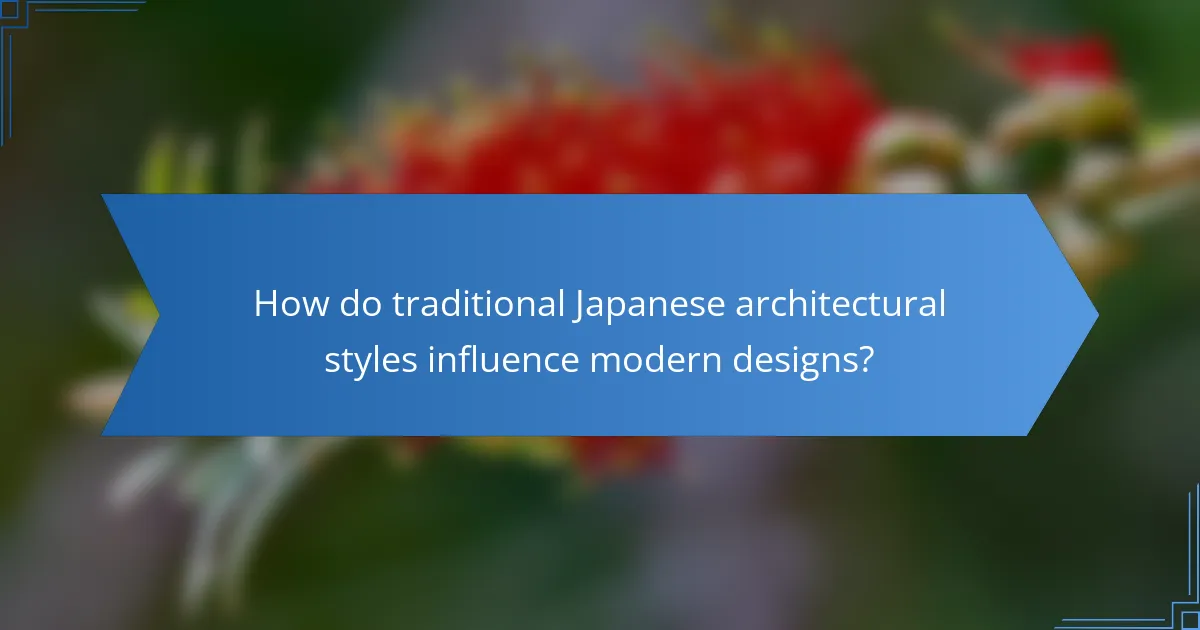
How do traditional Japanese architectural styles influence modern designs?
Traditional Japanese architectural styles significantly influence modern designs by emphasizing harmony with nature, simplicity, and craftsmanship. Elements such as open floor plans, sliding doors, and natural materials are prevalent in contemporary architecture.
The use of tatami mats and shoji screens reflects a minimalist aesthetic that prioritizes functionality and tranquility. Modern architects often incorporate these features to create spaces that foster connection to the environment.
Additionally, the concept of “ma,” or negative space, is increasingly recognized in modern design, enhancing the flow and balance of interiors. This principle encourages thoughtful placement of objects, promoting a sense of serenity.
Incorporating these traditional elements not only preserves cultural heritage but also addresses contemporary needs for sustainable and mindful living.
What are the key characteristics of Shinto shrines?
Shinto shrines are characterized by their unique architectural styles, natural materials, and spiritual symbolism. Key features include torii gates, which mark the entrance, and honden, the main sanctuary housing the kami. The use of wood, thatch, and stone reflects harmony with nature. Additionally, many shrines incorporate a simple design, emphasizing minimalism and tranquility. Unique attributes include the specific regional styles, such as the Ise Shrine’s distinct architectural form, which is rebuilt every 20 years to maintain purity.
How does Zen Buddhism shape architectural aesthetics?
Zen Buddhism profoundly influences architectural aesthetics in Japan by emphasizing simplicity, harmony, and natural materials. This approach results in serene spaces that promote meditation and reflection. Notable features include the use of asymmetry, open spaces, and integration with nature, which highlight tranquility and balance. Traditional structures like Zen gardens and tea houses exemplify these principles, showcasing a unique attribute of Zen architecture that prioritizes spiritual experience over ornate design. The minimalist aesthetic fosters a deep connection between the built environment and the surrounding landscape, creating a cohesive visual narrative.
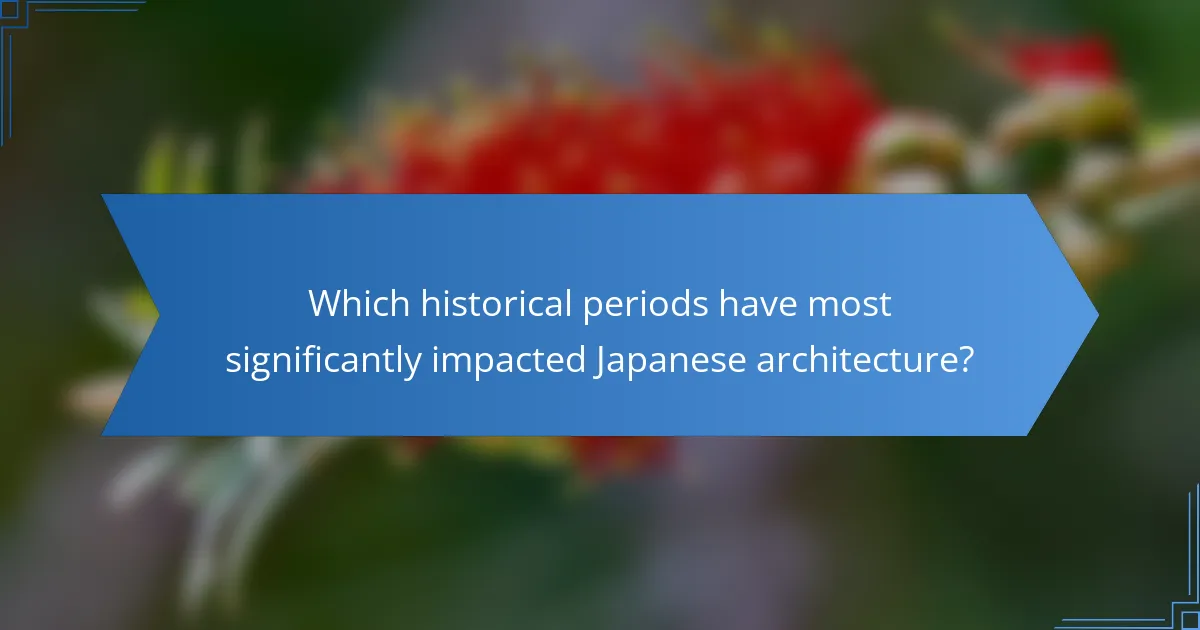
Which historical periods have most significantly impacted Japanese architecture?
Japanese architecture has been profoundly shaped by periods such as the Asuka, Nara, Heian, Kamakura, Muromachi, Edo, and modern eras. Each period introduced unique styles and techniques, reflecting cultural and historical shifts.
The Asuka period (538-710) marked the introduction of Buddhist architecture, with temples like Horyu-ji showcasing early wooden structures. The Nara period (710-794) saw the establishment of capital cities, leading to more sophisticated temple designs and urban planning.
During the Heian period (794-1185), the focus shifted to residential architecture, exemplified by the elegant designs of the aristocracy. The Kamakura period (1185-1333) introduced simplicity and functionality in response to the samurai class’s needs.
The Muromachi period (1336-1573) emphasized the integration of nature in design, evident in Zen temples. The Edo period (1603-1868) brought urbanization and the development of unique styles like Sukiya-zukuri, blending aesthetics with practicality.
In contemporary times, modern architecture in Japan reflects global influences while maintaining traditional elements, showcasing a unique architectural identity.
What architectural innovations emerged during the Edo period?
Architectural innovations during the Edo period include the development of wooden structures, intricate joinery techniques, and the use of tatami mats. These features reflect a blend of functionality and aesthetic appeal. Unique attributes such as the construction of shinto shrines and zen temples emphasized harmony with nature. Additionally, the emergence of urban planning in cities like Edo showcased the importance of public spaces and infrastructure. These innovations significantly influenced Japanese architecture, creating a distinct style that resonates today.
How did Western influence reshape Japanese architectural practices in the Meiji era?
Western influence significantly reshaped Japanese architectural practices during the Meiji era by introducing Western styles and construction techniques. This period saw the integration of Western elements, such as brick and stone, into traditional Japanese designs.
The adoption of neoclassical and Gothic styles marked a departure from the purely wooden structures typical of earlier Japanese architecture. For instance, the Tokyo Station, completed in 1914, showcases a blend of Western architectural principles with traditional Japanese aesthetics.
As a result, Japan’s architectural landscape transformed, reflecting modernization and cultural exchange. This shift also included the establishment of formal architectural education, which further influenced the development of new styles and practices.
Overall, the Meiji era exemplifies a unique fusion of Eastern and Western architectural philosophies, resulting in iconic structures that symbolize Japan’s modernization journey.
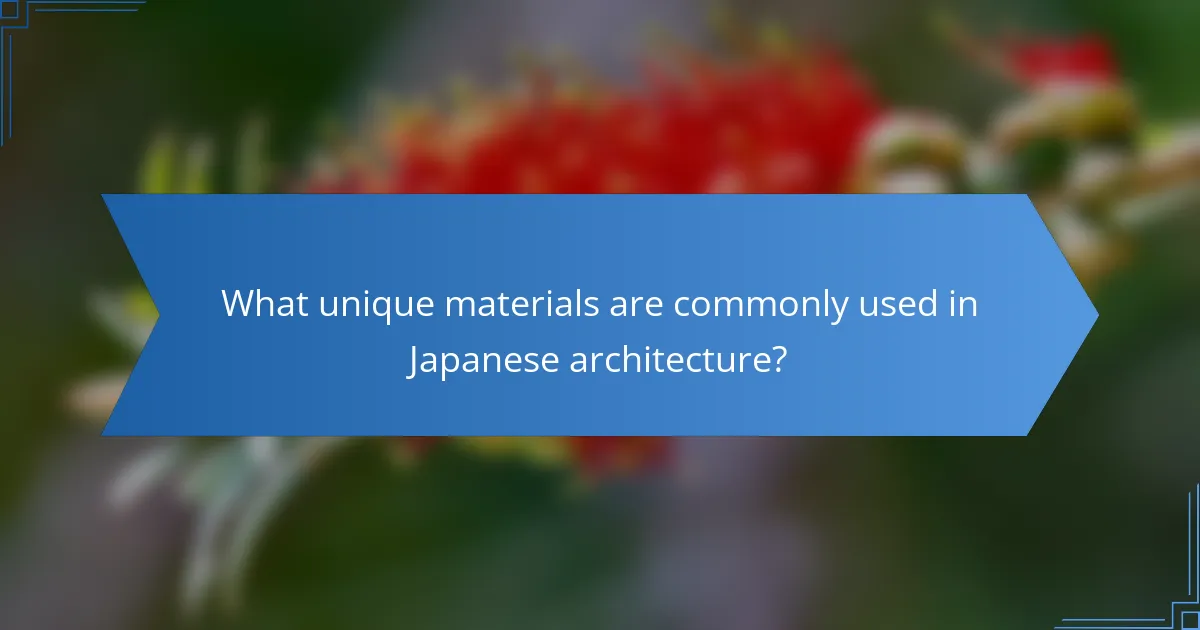
What unique materials are commonly used in Japanese architecture?
Japanese architecture commonly utilizes unique materials such as wood, paper, and clay. Wood, particularly from cedar and cypress, is favored for its durability and aesthetic appeal. Traditional shoji screens, made of wood and rice paper, provide natural light while maintaining privacy. Clay is often used in roof tiles and plaster, contributing to thermal regulation. These materials not only reflect Japan’s cultural heritage but also adapt to the environment.
How does the use of wood reflect cultural values in construction?
The use of wood in Japanese construction reflects cultural values such as harmony with nature, tradition, and craftsmanship. Wood is favored for its natural aesthetics and sustainability, aligning with the Shinto belief in the sacredness of nature. Traditional techniques, like joinery, emphasize skill and respect for materials, showcasing a deep cultural heritage. Moreover, wooden structures, such as temples and shrines, symbolize impermanence and the beauty of aging, resonating with the Japanese aesthetic of wabi-sabi.
What role does tatami play in interior design?
Tatami plays a crucial role in Japanese interior design by providing a unique aesthetic and functional benefits. It enhances the ambiance with its natural materials and traditional craftsmanship. Tatami mats create a sense of harmony and tranquility, essential in Japanese homes. They also contribute to space efficiency by defining areas for activities and promoting a minimalist lifestyle. The texture and warmth of tatami enhance comfort, making it a favored choice in various interior styles.
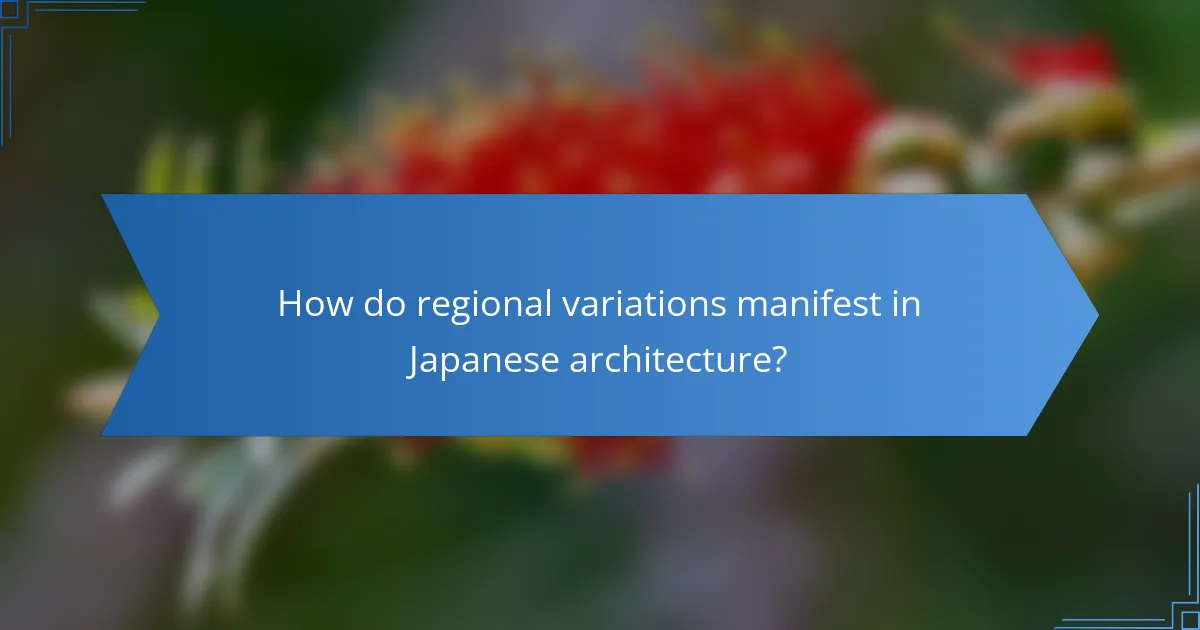
How do regional variations manifest in Japanese architecture?
Regional variations in Japanese architecture manifest through distinct styles and materials influenced by local climate, culture, and history. For example, traditional homes in snowy regions feature steep roofs to prevent snow accumulation, while coastal areas often utilize wooden structures resistant to humidity. Unique attributes include the use of tatami mats in interiors, varying from region to region. Additionally, local craftsmanship, such as the intricate joinery seen in Kyoto’s temples, highlights rare techniques that differ across Japan. These architectural nuances reflect the diverse cultural heritage and environmental adaptations found within the country.
What distinguishes the architecture of Kyoto from that of Tokyo?
Kyoto’s architecture emphasizes traditional wooden structures and intricate designs, while Tokyo showcases modern skyscrapers and innovative styles. Kyoto features historic temples and shrines, reflecting its cultural heritage. In contrast, Tokyo’s architecture represents rapid urbanization and technological advancement. Notable examples include Kyoto’s Kinkaku-ji and Tokyo’s Tokyo Tower. The unique attribute of Kyoto’s architecture lies in its preservation of ancient aesthetics, whereas Tokyo’s rare attribute is its blend of the ultra-modern with the historical.
Which coastal structures highlight Japan’s relationship with the sea?
Japan’s coastal structures reflect a deep connection with the sea, showcasing architectural ingenuity. Notable examples include the Itsukushima Shrine, known for its floating torii gate, and the Himeji Castle, which offers stunning views of the surrounding waters. Coastal fishing villages like Ine preserve traditional wooden boathouses, emphasizing harmony with maritime life. The Shimanami Kaido, a scenic cycling route, features bridges connecting islands, enhancing accessibility and appreciation of the coastal landscape. Each structure embodies unique aspects of Japan’s cultural and historical relationship with the sea.
![]()
What are the most iconic architectural wonders in Japan?
Japan is home to numerous iconic architectural wonders that reflect its rich history and diverse styles. Notable examples include the ancient Himeji Castle, known for its stunning white exterior and intricate design, and the modern Tokyo Skytree, which stands as the tallest structure in Japan at 634 meters. The traditional wooden temples, such as Kinkaku-ji, the Golden Pavilion, showcase exquisite craftsmanship and harmony with nature. Additionally, the unique blend of traditional and contemporary architecture can be seen in buildings like the National Art Center in Tokyo. These structures not only serve functional purposes but also symbolize Japan’s cultural heritage and artistic innovation.
How does Himeji Castle exemplify feudal architecture?
Himeji Castle exemplifies feudal architecture through its intricate design and defensive features. The castle, built in the 17th century, showcases a unique blend of functionality and aesthetics. Its white plaster walls reflect a rare attribute, symbolizing purity and strength. The complex includes multiple gates and moats, enhancing security, which is a root characteristic of feudal structures. Additionally, the castle’s tiered roofs and ornate decorations highlight the unique artistry of the period, making it a premier example of Japanese feudal architecture.
What makes the Great Buddha of Nara a significant cultural landmark?
The Great Buddha of Nara is significant due to its immense size, historical importance, and artistic craftsmanship. Completed in 752 AD, this bronze statue stands approximately 15 meters tall, symbolizing the cultural exchange between Japan and China. Its creation involved thousands of artisans and reflects the unique artistic style of the period. The statue is housed in Todai-ji Temple, a UNESCO World Heritage Site, further enhancing its cultural relevance. As a rare attribute, the Great Buddha represents the spiritual and philosophical ideals of Buddhism, making it a focal point for both worship and tourism.
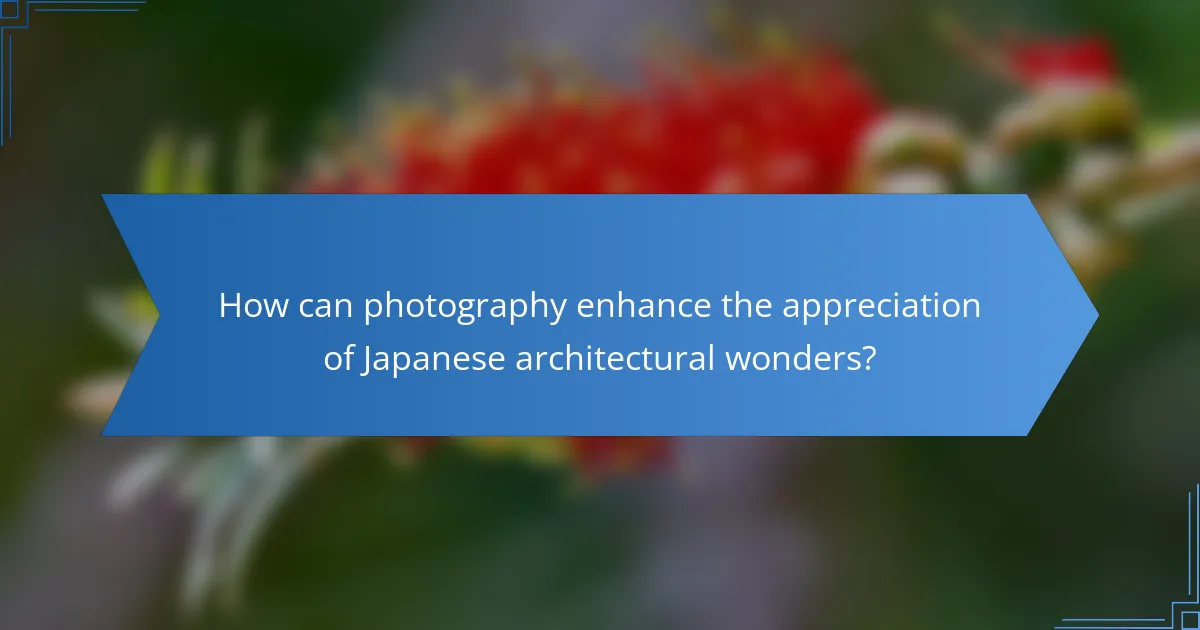
How can photography enhance the appreciation of Japanese architectural wonders?
Photography enhances the appreciation of Japanese architectural wonders by capturing their intricate details and cultural significance. Visual documentation allows viewers to explore architectural styles like Shinto shrines and Buddhist temples, showcasing unique attributes such as wooden construction and harmonious integration with nature. Photographs serve as a bridge, connecting historical context with contemporary perspectives, and highlight rare architectural features like the use of tatami and sliding doors. As a result, photography not only preserves these structures but also invites deeper engagement and understanding of Japan’s rich architectural heritage.
What techniques are best for capturing the essence of traditional structures?
To capture the essence of traditional structures in Japan, focus on techniques that emphasize authenticity and detail. Utilize photography that highlights unique architectural features, such as intricate woodwork and harmonious integration with nature. Employ natural lighting to enhance textures and colors, showcasing the beauty of materials like bamboo and tatami. Consider angles that reflect the cultural significance of the structures, such as traditional temples and shrines. Lastly, incorporate historical context in your narrative to enrich the viewer’s understanding of these architectural wonders.
Which times of day offer the best lighting for architectural photography?
The best lighting for architectural photography occurs during the golden hour, shortly after sunrise and before sunset. This time provides warm, soft light that enhances the details and textures of structures. Midday lighting can be harsh, creating strong shadows and unflattering contrasts. Overcast days can also offer diffused light, which is beneficial for capturing the subtle features of buildings without harsh highlights.
What common mistakes should photographers avoid when shooting architecture?
Photographers should avoid common mistakes like poor composition, incorrect lighting, and neglecting context. These errors can diminish the architectural beauty and storytelling in images.
First, ensure proper framing to highlight the structure’s unique attributes. Use leading lines and symmetry to create visually appealing compositions.
Second, be mindful of lighting conditions. Shooting during golden hour enhances textures and colors, while harsh midday light can create unflattering shadows.
Lastly, consider the surroundings. Including elements of the environment can provide context and depth, making the architecture more relatable and engaging.

What practical tips can enhance the exploration of Japanese architecture?
To enhance the exploration of Japanese architecture, focus on local insights and practical experiences. Engage with architects and historians to gain deeper perspectives. Visit diverse regions to appreciate various styles, such as Shinto shrines and modern structures. Document your journey through photography to capture unique details and contrasts. Attend architectural tours or workshops for hands-on learning.
How to plan a photography-focused architectural tour in Japan?
To plan a photography-focused architectural tour in Japan, identify key architectural styles, historical landmarks, and optimal photography times. Start by selecting cities known for their distinct architectural wonders, such as Tokyo, Kyoto, and Osaka.
1. Research architectural styles like traditional Japanese, modern, and contemporary designs.
2. Create an itinerary featuring iconic structures like the Tokyo Skytree and Kinkaku-ji.
3. Consider the best times for photography, such as early morning or late afternoon for natural lighting.
4. Plan visits during seasonal events, like cherry blossom season, for unique photo opportunities.
5. Utilize local guides or photography workshops to enhance your experience and skills.
This approach ensures a comprehensive exploration of Japan’s architectural beauty while capturing stunning photographs.
What resources are available for learning about Japanese architectural history?
Numerous resources exist for learning about Japanese architectural history, including books, online courses, and documentaries. Key texts such as “Japanese Architecture: A History” provide foundational knowledge. Online platforms like Coursera and edX offer courses on Japanese culture and architecture. Additionally, museums in Japan often host exhibitions that focus on architectural styles and history, providing visual insights. Documentaries, available on streaming services, explore significant architectural movements and notable structures.
How can one engage with local experts or institutions for deeper insights?
Engaging with local experts or institutions enhances understanding of Japan’s architectural wonders. Attend workshops at universities like the University of Tokyo or participate in guided tours led by architecture firms. Collaborate with local museums, such as the National Museum of Western Art, which often host lectures and exhibitions. Networking with professionals through events or social media platforms can provide valuable insights. Additionally, consider joining local architectural societies or associations for deeper engagement.